Nestled in northern Thailand, the ancient city of Sukhothai holds a pivotal place in the country’s history. Once the capital of the first Thai kingdom, Sukhothai is often referred to as the birthplace of Thai civilization. Its name, meaning “Dawn of Happiness,” symbolizes the emergence of a prosperous kingdom.
Today, Sukhothai is a UNESCO World Heritage Site, renowned for its breathtaking temples, majestic palaces, and timeless monuments. These architectural marvels offer visitors an immersive journey into Thailand’s glorious past.
The city’s historical park, dotted with ancient ruins, provides a serene and evocative setting where one can almost hear the echoes of a bygone era.
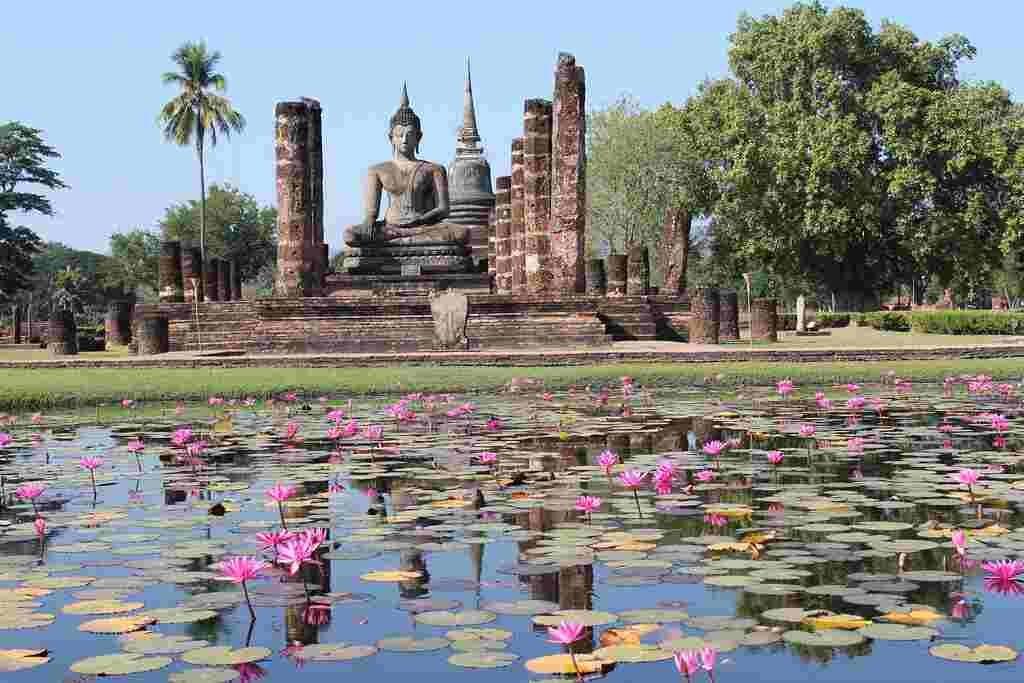
The History of Sukhothai
The city of Sukhothai, meaning “Dawn of Happiness,” is often regarded as the birthplace of Thai civilization. It was the capital of the first Thai Kingdom, the Sukhothai Kingdom, which flourished from 1238 to 1438 CE.
The kingdom was founded by King Si Inthrathit, who united several Thai polities under his rule, marking the beginning of a new era of independence from the Khmer Empire.
Founding and Early History
Sukhothai started as a small outpost of the Khmer Empire, known for its Hindu temples and canals reminiscent of Angkor Wat. In 1238, the city declared its independence from the Khmer Empire under the leadership of Si Inthrathit, establishing the Sukhothai Kingdom.
This period marked the beginning of a cultural and political renaissance in the region.
Golden Age under King Ramkhamhaeng
The third ruler of Sukhothai, King Ramkhamhaeng (1279-1298 CE), is often credited with the kingdom’s golden age. He expanded the kingdom’s territory significantly, extending its influence over present-day Laos, Myanmar, and Malaysia.
King Ramkhamhaeng is also celebrated for creating the Thai alphabet, which laid the foundation for Thai literature and administration.
Cultural and Religious Flourishing
Sukhothai became a major center of Theravada Buddhism, which was introduced from Sri Lanka. The kingdom saw the construction of numerous temples and monasteries, many of which still stand today as part of the Sukhothai Historical Park.
The architectural style developed during this period, characterized by elegant stupas and Buddha images, influenced Thai art and architecture for centuries.
Decline and Legacy
The Sukhothai kingdom began to decline in the late 14th century and was eventually absorbed by the more powerful Ayutthaya Kingdom in 1438. Despite its relatively short existence, Sukhothai left an indelible mark on Thai culture, art, and politics.
The city’s ruins, now a UNESCO World Heritage Site, continue to attract visitors from around the world, offering a glimpse into Thailand’s rich historical heritage.
Re Discovery of Sukhothai
The ancient city of Sukhothai, once the capital of the first Thai Kingdom, fell into obscurity after its decline and eventual absorption by the Ayutthaya Kingdom in 1438.
For centuries, the ruins of this once-glorious city lay hidden, overgrown by the dense forests of northern Thailand.
Re Discovery by King Rama IV
The rediscovery of Sukhothai is credited to King Rama IV of Siam, also known as King Mongkut. Before ascending to the throne, King Mongkut spent many years as a monk, during which he traveled extensively across Thailand.
In 1833, during one of his journeys, he came across the ruins of Sukhothai. Fascinated by the remnants of the ancient city, he initiated efforts to study and preserve its historical significance.
Archaeological Efforts
The rediscovery sparked a renewed interest in Sukhothai’s history and architecture. Throughout the 19th and 20th centuries, Thai kings and archaeologists made significant efforts to excavate and restore the ruins.
These efforts were instrumental in uncovering the city’s layout, including its temples, palaces, and monuments.
UNESCO World Heritage Site
In 1991, the historical significance of Sukhothai was internationally recognized when it, along with the neighboring ruins of Si Satchanalai and Kamphaeng Phet, was declared a UNESCO World Heritage Site.
This designation helped to further preserve and promote the site, attracting scholars, historians, and tourists from around the world.
Modern-Day Sukhothai
Today, Sukhothai Historical Park stands as a testament to the city’s rich heritage.
Visitors can explore the well-preserved ruins, which offer a glimpse into the architectural and cultural achievements of the Sukhothai kingdom. The park is meticulously maintained, with informative displays and guided tours that bring the history of Sukhothai to life.
In Summary, The rediscovery of Sukhothai by King Rama IV marked the beginning of a new chapter in the city’s history. From a forgotten ruin to a celebrated historical site, Sukhothai’s journey is a testament to the enduring legacy of Thailand’s cultural heritage.
Visiting Sukhothai today is not just an exploration of ancient ruins but a celebration of the rediscovery and preservation of a pivotal chapter in Thai history.
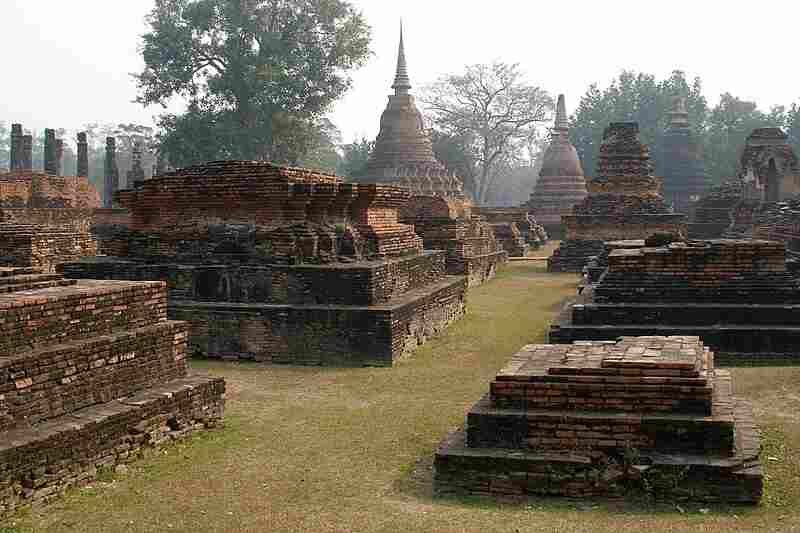
Legends and Myths of Sukhothai
Sukhothai, with its rich history and cultural heritage, is enveloped in a tapestry of legends and myths that add to its allure and mystique.
These stories, passed down through generations, offer a fascinating glimpse into the spiritual and cultural fabric of the ancient kingdom.
The Legend of King Ramkhamhaeng’s White Elephant
One of the most enduring legends of Sukhothai revolves around King Ramkhamhaeng and his revered white elephant. According to the tale, King Ramkhamhaeng possessed a majestic white elephant, a symbol of royal power and divine favor in Thai culture.
The elephant was not only a royal treasure but also believed to have a spiritual connection with the gods. The legend narrates that during one of the king’s journeys, the white elephant led him to a particular spot in the dense forests of northern Thailand.
Upon reaching this location, the elephant knelt down in reverence, signaling that this was a sacred place chosen by divine will. Interpreting this as a sign from the heavens, King Ramkhamhaeng decided to establish the city of Sukhothai at this very site.
The kneeling of the white elephant is seen as a divine endorsement of the city’s foundation, marking it as a place of great spiritual and historical significance.
The Sacred Pond of Traphang Ngoen
Another captivating legend associated with Sukhothai is that of the sacred pond of Traphang Ngoen. This pond, located within the Sukhothai Historical Park, is believed to possess mystical healing properties.
The legend tells of a time when the people of Sukhothai were suffering from a severe drought. The crops were failing, and the water sources were drying up, leading to widespread distress.
In their desperation, the people prayed to the gods for relief. One night, a divine vision appeared to a local monk, instructing him to dig at a specific spot within the city.
Following the vision, the monk and the villagers began to dig and soon discovered a hidden spring. As the water flowed, it filled the pond, which came to be known as Traphang Ngoen, or the “Silver Pond.”
The waters of Traphang Ngoen were believed to be blessed by the gods, and it was said that those who bathed in or drank from the pond would be healed of their ailments.
The pond became a place of pilgrimage, attracting people from far and wide seeking its miraculous waters. Even today, the legend of Traphang Ngoen endures, and the pond remains a symbol of divine benevolence and healing.
In Summary, The legends and myths of Sukhothai enrich its historical narrative, adding layers of spiritual and cultural depth to the ancient city.
These stories not only highlight the city’s significance in Thai history but also reflect the deep-rooted beliefs and traditions of its people.
Exploring Sukhothai is not just a journey through its physical ruins but also an immersion into the enchanting tales that have shaped its legacy.
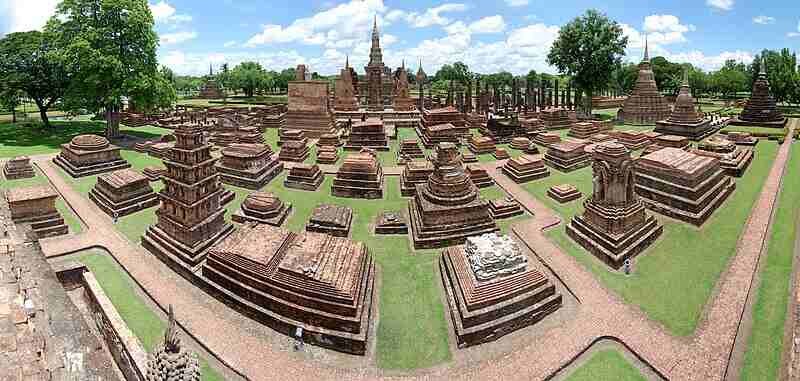
Sukhothai Historical Park
Covering an area of approximately 70 square kilometers, The Sukhothai Historical Park contains 193 ruins, including 26 temples within the royal palace complex, showcasing the remnants of the capital city that flourished under the rule of King Ramkhamhaeng and his predecessors.
The park was officially opened in 1988 and has since become one of Thailand’s most popular tourist destinations, attracting visitors eager to explore its historical significance and stunning landscapes.
Must-See Attractions Within the Sukhothai Historical Park
Sukhothai Historical Park is a treasure trove of ancient ruins and historical wonders. Here are some must-see attractions within the park.
1. Wat Mahathat
Wat Mahathat is the most significant temple in Sukhothai Historical Park and serves as the spiritual center of the ancient kingdom.
Architecture: The Temple features a central stupa surrounded by smaller stupas arranged in a mandala layout, symbolizing the universe. The main chedi is designed in the lotus style, showcasing Khmer architectural influence.
Buddha Statues: Two impressive 9-meter-tall standing Buddha statues, known as Phra Attharot, flank the main stupa. Visitors can also explore around 200 subordinate chedis within the temple complex.
2. Wat Si Chum
Famous for its giant seated Buddha image, Wat Si Chum is one of Sukhothai’s most photographed sites.
The Buddha: Known as Phra Achana or “the Buddha who is not afraid,” this statue stands at approximately 15 meters high and 11 meters wide. The temple features a unique design that allows visitors to see the Buddha through a slit in its mondop.
Historical Significance: Legend has it that King Naresuan used this image to boost his army’s morale during battles against the Burmese, making it an iconic symbol of strength and faith.
3. Wat Traphang Ngoen
Located near Wat Mahathat, this temple features a large standing Buddha image and a beautiful lotus pond, making it a serene spot for reflection.
Scenic Beauty: The temple’s setting makes it an ideal spot for photography, especially at sunrise or sunset when the light casts beautiful hues across the water.
Cultural Experience: Visitors can enjoy peaceful walks around the pond while taking in the tranquil atmosphere that surrounds this ancient site.
4. Wat Sa Si
Connected by a bridge to Wat Traphang Ngoen, Wat Sa Si is another significant temple within the park.
Unique Features: This temple features a large chedi surrounded by smaller stupas and offers beautiful views of both Wat Traphang Ngoen and its reflective pond.
Accessibility: The easy access from other main attractions makes it a convenient stop for visitors exploring the park.
5. Wat Phra Pai Luang
Wat Phra Phai Luang in Sukhothai Historical Park is an ancient temple showcasing early architectural styles of the Sukhothai kingdom.
The main prang, adorned with intricate carvings, reflects Khmer influence. Surrounding stupas complement its design. The vihara offers insights into communal practices. Buddha statues throughout the temple signify devotion.
Originally a Hindu temple, its conversion to Buddhism signifies historical transitions and a blend of religious motifs in its architecture, making it historically significant.
Wat Phra Phai Luang was a major religious center in Sukhothai, serving spiritual and community activities near the city’s northern gate.
Visiting the temple provides cultural insights into the Sukhothai Kingdom’s history and artistic achievements. Its architecture showcases a blend of Khmer and Thai styles, highlighting the region’s cultural identity.
The intricate carvings and reliefs display the skilled craftsmanship of the Sukhothai period, making it a must-visit attraction in Sukhothai Historical Park for a deeper appreciation of its heritage.
6. Wat Sorasak
Wat Sorasak is renowned for its unique and charming elephant statues that encircle the base of its chedi. Each of the 24 elephant statues is meticulously crafted, symbolizing strength and protection.
The chedi itself is a bell-shaped structure, typical of Sukhothai architecture, and the elephants appear to be supporting it, creating a visually striking and symbolic representation of stability and power.
The temple’s serene atmosphere and the detailed artistry of the elephant statues make it a captivating site for visitors.
7. Wat Chetuphon
Wat Chetuphon stands out for its impressive four-faced Buddha statue, which represents the Buddha looking in all four cardinal directions, symbolizing his omnipresence and wisdom.
The temple is also known for its well-preserved stucco reliefs that adorn the walls, depicting scenes from the life of the Buddha and various mythological stories.
These intricate reliefs showcase the artistic achievements of the Sukhothai period, reflecting the high level of craftsmanship and the rich cultural heritage of the era.
The temple’s tranquil setting and historical significance make it a must-visit for those interested in ancient Thai art and architecture.
8. Wat Saphan Hin
Perched on a hill, Wat Saphan Hin offers a breathtaking panoramic view of the Sukhothai Historical Park. The temple is famous for its large standing Buddha statue, which stands at an impressive height of 12.5 meters.
The statue, known as Phra Attharot, is a striking example of Sukhothai sculpture, characterized by its graceful and serene expression.
The stone pathway leading up to the temple, known as the “Stone Bridge,” adds to the site’s historical charm.
Climbing the pathway and reaching the temple provides a sense of pilgrimage, rewarding visitors with stunning views and a peaceful ambiance.
9. Wat Si Sawai
Wat Si Sawai is distinguished by its three Khmer-style prangs (towers), which are reminiscent of the architectural style found in Angkor Wat, Cambodia.
These prangs are adorned with intricate carvings and stucco decorations, depicting Hindu deities and mythological scenes, reflecting the temple’s origins as a Hindu shrine before it was converted to a Buddhist temple.
The central prang is the tallest and most elaborately decorated, symbolizing Mount Meru, the center of the universe in Hindu and Buddhist cosmology.
The blend of Thai and Khmer architectural styles at Wat Si Sawai highlights the cultural exchanges and influences that shaped the Sukhothai Kingdom.
10. Ramkhamhaeng National Museum
One of the most remarkable features of the Sukhothai Historical Park is the exquisite Buddha statues found throughout the site. These statues, which blend Khmer, Sri Lankan, and distinctly Sukhothai styles, are renowned for their beauty and craftsmanship.
Many of the most important Sukhothai Buddha statues are housed in the Ramkhamhaeng National Museum, which was opened in 1964 by King Bhumibol Adulyadej and Queen Sirikit. The museum’s collection includes a wide range of Buddhist art, much of which was donated by the abbot of Ratchathani Temple and local residents.
Exploring these attractions will give you a comprehensive understanding of the architectural and cultural heritage of the Sukhothai Kingdom. Enjoy your journey through this historical gem!
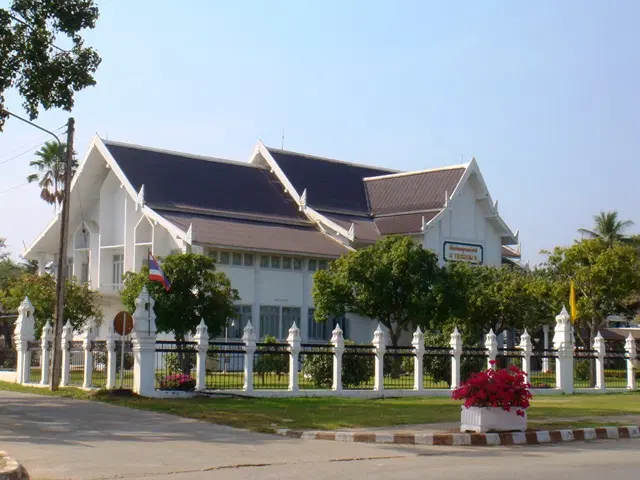
Visiting Sukhothai, Thailand: A Comprehensive Guide
Sukhothai, a UNESCO World Heritage Site, is a must-visit destination for history buffs and culture enthusiasts. Here’s a comprehensive guide to help you plan your trip
Different Modes of Travel
1. By Air:
Direct Flights: Bangkok Airways operates daily flights from Bangkok to Sukhothai Airport, located about 40 kilometers from the historical park.
Alternative Airports: You can also fly into Phitsanulok Airport (around 80 km away), served by Air Asia and Thai Lion Air.
2. By Train: There are no direct trains to Sukhothai. You can take a train to Phitsanulok and then a bus or taxi to Sukhothai.
3. By Bus:
Buses connect Sukhothai with major cities like Bangkok and Chiang Mai. The bus ride typically takes 6-8 hours from Bangkok and about 4-6 hours from Chiang Mai.
4. Local Transport:
Once in Sukhothai, you can use tuk-tuks or songthaews (shared taxis) to reach your accommodation or the historical park.
5. By Car: Renting a car is a convenient option, especially if you plan to explore nearby attractions.
Distances from Sukhothai to Major Cities in Thailand
Here are the approximate distances from Sukhothai to various major cities in Thailand:
1. Bangkok:
Straight Line Distance: 373 km (232 miles)
Driving Distance: 428 km (266 miles)
2. Chiang Mai:
Distance: 217 km (135 miles)
3. Phitsanulok:
Distance: 80 km (49 miles)
4. Ayutthaya:
Distance: 300 km (186 miles)
5. Chiang Rai:
Distance: 400 km (249 miles)
6. Pattaya:
Distance: 490 km (304 miles)
7. Hua Hin:
Distance: 550 km (342 miles)
8. Phuket:
Distance: 1,200 km (746 miles)
These distances can help you plan your travel itinerary more effectively.
Festivals and Rituals
Sukhothai hosts several cultural events throughout the year:
King Ramkhamhaeng’s Great Memorial Fair (January): Celebrates the legacy of King Ramkhamhaeng with various cultural activities.
Loy Krathong Festival: Celebrated in November, this festival involves floating decorated baskets on water to honor the river goddess. Sukhothai’s celebration is one of the most authentic and grand, featuring fireworks, folk dancing, and a light and sound show.
Songkran Festival: The Thai New Year in April is celebrated with water fights and traditional rituals.
Opening Times and Entry Fee
Opening Time
Sukhothai Historical Park: Open daily from 6:00 AM to 7:30 PM.
Entry Fee
The park is divided into zones, Each zone has an entrance fee of 100 Baht for foreigners and 30 Baht for Thais.
Best Time to Visit
The ideal time to visit Sukhothai is during the cool season from November to February when temperatures are more comfortable for exploring outdoor sites. This period also coincides with many festivals.
Dress Code
When visiting temples and historical sites, it is important to dress respectfully. Visitors should wear clothing that covers the shoulders and knees.
Lightweight, breathable fabrics are recommended due to the warm climate. It’s also advisable to wear comfortable shoes, as you will be walking on uneven surfaces.
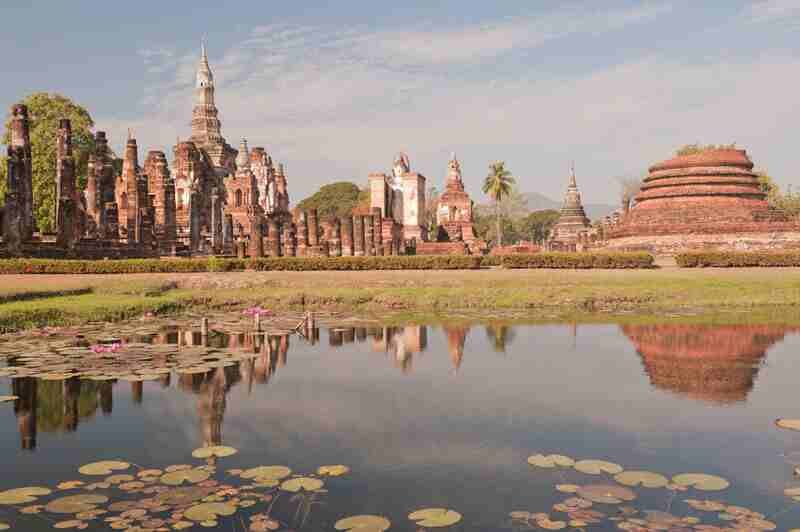
Accommodation
Sukhothai offers a range of accommodation options to suit different budgets and preferences. From luxury resorts to budget guesthouses, there’s something for everyone.
Luxury Option: Legendha Sukhothai Hotel – Located just 1 km from Old Town, this hotel features traditional Thai decor and modern amenities.
Budget-Friendly Option: Jitra Resort – A boutique guesthouse in New Sukhothai offering affordable rates and easy access to local eateries.
Guest houses: Numerous locally run guesthouses are available in both New and Old Sukhothai for various budgets.
Local Delicacies
Sukhothai is famous for its unique culinary offerings. Be sure to try:
Sukhothai Noodles (Kuay Tiaw Sukhothai): A local specialty made with thin rice noodles served in a clear broth with pork, green beans, peanuts, and lime. It’s known for its sweet and tangy flavor.
Khao Perb: A local noodle dish made from steamed rice flour sheets, often served with a variety of toppings such as minced pork, garlic, and herbs.
Grilled Fish (Pla Pao): Freshly caught fish, typically tilapia or catfish, grilled to perfection and often served with spicy dipping sauces like nam jim.
Grilled Pork Skewers (Moo Ping): Tender and flavorful pork skewers marinated in a sweet and savory sauce, a popular street food.
Sukhothai-style Fried Rice: A local twist on the classic dish, often served with fresh vegetables, herbs, and a fried egg on top.
Sticky Rice Desserts (Khao Niew Moon): Various sweet treats made from glutinous rice, often mixed with coconut milk and topped with mango or other fruits.
Khao Soi: A flavorful curry noodle dish with a rich coconut milk base, typically served with chicken or beef, and garnished with crispy noodles, pickled mustard greens, and lime.
Gaeng Daeng (Red Curry): A spicy red curry made with coconut milk, red curry paste, and a variety of meats or tofu, often served with jasmine rice.
Nam Prik Num: A Northern Thai chili dip made from roasted green chilies, garlic, and shallots, served with an assortment of fresh and steamed vegetables.
Khanom Jeen: Fermented rice vermicelli noodles served with a variety of spicy curry sauces, often accompanied by fresh vegetables and herbs.
These dishes offer a delightful taste of Sukhothai’s rich culinary heritage. Enjoy exploring the flavors of this historic city!
Nearby Attractions
In addition to the historical park, Sukhothai has several nearby attractions worth exploring:
Si Satchanalai Historical Park: Located about 60 km north of Sukhothai, this site features more ancient ruins from the same era. It is known for its well-preserved temples and monuments, offering a quieter and less crowded alternative to Sukhothai Historical Park.
Kamphaeng Phet Historical Park: Another UNESCO World Heritage Site, this park showcases ancient temples and fortifications. It provides insight into the defensive architecture of the Sukhothai and Ayutthaya periods.
Bueng Boraphet: A large freshwater lake located in Nakhon Sawan province, about 195 km from Sukhothai. It is known for its beautiful scenery and is a popular spot for birdwatching, especially during the migratory season.
Phra Ruang Hot Springs: A relaxing spot to unwind in natural hot springs, located about 70 kilometers from Sukhothai. The hot springs are believed to have therapeutic properties and are a great place to relax after a day of exploring.
Phitsanulok: The nearest city to Sukhothai, offering a variety of attractions, including Wat Phra Si Rattana Mahathat, which houses the famous Phra Buddha Chinnarat statue. The city also has museums, shopping malls, and a vibrant night market.
By following this guide, you can plan a memorable trip to Sukhothai and experience the rich history and culture of this fascinating destination.
♣♣You May Also Like: ⇓
- Remarkable Blue Temple of the Chiang Rai, Thailand
- Beautiful Wat Rong Khun: Thailand’s Famous White Temple
- Outstanding Yasaka Pagoda: A Timeless Landmark in Kyoto
- Colorful Wat Arun: Beautiful Temple of Dawn in Thailand
- Unique Devni Mori: A old and Lost Buddhist Heritage
Conclusion
Sukhothai is more than just a historical site; it is a vibrant tapestry woven with the threads of culture, tradition, and community spirit.
The festivals and rituals celebrated throughout the year not only honor the rich heritage of this ancient city but also invite visitors to immerse themselves in the timeless customs that have shaped the lives of the local people for centuries.
From the mesmerizing beauty of the Loy Krathong Festival to the joyful exuberance of Songkran, each event offers a unique glimpse into the heart and soul of Sukhothai.
As you explore the captivating ruins, partake in the lively celebrations, and savor the local delicacies, you will find that Sukhothai is a place where history comes alive and connections are forged.
Whether you are a history enthusiast, a culture seeker, or simply a traveler in search of beauty and inspiration, Sukhothai promises an unforgettable experience that resonates long after you leave.
So, step into this enchanting realm, and let the spirit of Sukhothai embrace you, enriching your journey with memories that will last a lifetime.
10 thoughts on “Tremendous Sukhothai, Thailand: A Rich Historic Hub”